Odisha State Board CHSE Odisha Class 12 Biology Important Questions Chapter 1 Reproduction in Organisms Important Questions and Answers.
CHSE Odisha 12th Class Biology Important Questions Chapter 1 Reproduction in Organisms
Reproduction in Organisms Class 12 Important Questions CHSE Odisha
Very Short Answer Type Questions
Choose the correct option
Question 1.
The factors which determine type of reproduction in an organism are
(a) habitat
(b) internal physiology
(c) environmental conditions
(d) All of the above
Answer:
(d) All of the above
Question 2.
A division which occurs at an angle to the transverse axis is called
(a) transverse binary fission
(b) longitudinal binary fission
(c) oblique binary fission
(d) simple binary fission
Answer:
(c) oblique binary fission
Question 3.
Conidia formation is seen in
(a) Amoeba
(b) Paramecium
(c) Aspergillus
(d) Planaria
Answer:
(c) Aspergillus
Question 4.
Sponges reproduce asexually by forming
(a) external buds
(b) gemmules
(c) merozoites
(d) None of these
Answer:
(b) gemmules
![]()
Question 5.
Cell division itself is a mode of reproduction in
(a) Amoeba
(b) Paramecium
(c) Both (a) and (b)
(d) None of these
Answer:
(c) Both (a) and (b)
Question 6.
Which one group of plants is propagated through underground roots?
(a) Bryophyllum and Kalanchoe
(b) Pistia and pineapple
(c) Ginger, potato and onion
(d) Sweet potato, Dahlia and Tapioca
Answer:
(d) Sweet potato, Dahlia and Tapioca
Question 7.
Vegetative propagation in mint occurs by
(a) offset
(b) rhizome
(c) sucker
(d) runner
Answer:
(c) sucker
Question 8.
A horizontal underground stem is a
(a) corm
(b) phylloclade
(c) rhizome
(d) rhizoid
Answer:
(c) rhizome
Question 9.
The process by which scion is inserted successfully into the stock to form a new plant is called
(a) layering
(b) cutting
(c) grafting
(d) budding
Answer:
(c) grafting
Question 10.
Micropropagation is a technique
(a) of production of true plants
(b) of production of mutants
(c) of production of variant species
(d) All of the above
Answer:
(a) of production of true plants
Question 11.
Bryophyllum undergoes vegetative propagation by means of
(a) leaf buds
(b) bulbil
(c) stem
(d) nodes
Answer:
(a) leaf buds
![]()
Correct the statements, if required, by changing the underlined word(s)
Question 1.
Yeasts generally reproduce asexually by fission.
Answer:
Yeasts generally reproduce asexually by budding.
Question 2.
External budding is the characteristic feature of Spongilla.
Answer:
External budding is the characteristic feamre of Hydra.
Question 3.
Bacteria mostly reproduce by gemmules.
Answer:
Bacteria mostly reproduce by transverse binary fission.
Question 4.
In higher organisms, cell division in itself is a mode of reproduction.
Answer:
lower
Question 5.
Onion and garlic are examples of corm.
Answer:
Onion and garlic are examples of bulb.
Question 6.
Almonds can be grown successfully if stock and scion are of different species.
Answer:
Almonds can be grown successfully if stock and scion are of related species.
Question 7.
In layering, roots are artificially induced to grow on the branches before they are detached from the parent plant.
Answer:
gootee
Question 8.
Rhizome, runner and bulb are the examples of underground stem.
Answer:
tuber
Fill in the blanks
Question 1.
The morphologically and genetically identical offsprings produced by asexual reproduction are called ………… .
Answer:
clones
Question 2.
A type of binary fission, occurring in the Euglena is called …………. .
Answer:
longitudinal binary fission
Question 3.
An.organism reproducing by fragmentation is …………… .
Answer:
Planaria
Question 4.
In Euglena, ………… binary fission is observed. (simple/longitudinal/transverse/oblique)
Answer:
longitudinal
Question 5.
Non-motile, exogenous spores of Penicillium are …………. (zoospores/oospores/conidia/ascospores)
Answer:
conidia
![]()
Question 6.
Transverse binary fission is observed in …………… . (Euglena, Paramecium, Amoeba)
Answer:
Paramecium
Question 7.
…………. is commonly practiced for root induction.
Answer:
Layering
Question 8.
In grafting, the rooted-plant is called stock and stem cutting of donor plant is called ………. .
Answer:
scion
Question 9.
Conifer cutting is practiced for propagating …………….. .
Answer:
pine
Question 10.
Rooting in stem cuttings is stimulated by using ………….. .
Answer:
auxin
Question 11.
The vegetative propagule in Agave is …………. .
Answer:
bulbil
Express the following in one or two word(s)
Question 1.
The process by which a living organism produces its offspring.
Answer:
Reproduction
Question 2.
Binary fission is seen in which phylum?
Answer:
Protozoa
Question 3.
An organism which performs internal budding.
Answer:
Spongilla
Question 4.
A process by which an organism develops its lost body part.
Answer:
Regeneration
Question 5.
What are the totipotent cells of Planaria called?
(Neoblasts, Sertoli cells, Follicular cells, Helper cells)
Answer:
Neoblasts
Question 6.
Name the biological process that enables continuity of species.
Answer:
Reproduction
Question 7.
The process of formation of spores in Aspergillus.
Answer:
Sporulation
![]()
Question 8.
Formation of 2-3 layered strong envelope around cyst.
Answer:
Encystment
Question 9.
Mode of vegetative propagation in Pistia.
Answer:
Offset
Question 10.
Name the undifferentiated mass of cells formed during culturing of cells.
Answer:
Callus
Question 11.
The alternative term used for air layering.
Answer:
Gootee
Question 12.
In which plant, air layering is done?
Answer:
Lemon
Question 13.
Name the vegetative propagules in Chrysanthemum.
Answer:
Sucker
Question 14.
A medicinal plant propagated by micropropagation.
Answer:
Atropa belladona
Short Answer Type Questions
Question 1.
Why is reproduction essential for the organisms?
Answer:
Reproduction is an important biological process that is essential for the organisms because
- it maintains life on earth.
- it results in addition of new individuals to the population, which finally leads to perpetuation of species.
- it creates variation among populations, which plays an important role in evolution.
Question 2.
Write a short note on multiple fission.
Answer:
Fission is a phenomenon of asexual reproduction in which the parent body divides into two or more daughter individuals. Multiple fission is a type of fission in which parent body divides into many small daughter individuals simultaneously, e.g. Plasmodium (the malarial parasite), Amoeba (during unfavourable conditions).
Question 3.
How does multiple fission occur in Amoeba?
Answer:
Amoeba reproduces by multiple fission during unfavourable conditions. It secretes three-layered protective cyst around itself. Its nucleus divides repeatedly to form several daughter nuclei.
Each daughter nucleus with a small amount of cytoplasm forms a daughter Amoeba called amoebae. Under favourable conditions, the cyst wall breaks up releasing young amoebae. Each young one develops pseudopodia, feeds and grows into an adult Amoeba.
![]()
Question 4.
Why is it that there is no natural death in single-celled organisms like Amoeba and bacteria?
Answer:
In single-celled organisms like Amoeba and bacteria, the parental body itself divides into two parts and becomes daughter cells. Each of these divided cell rapidly grows into an adult organism. Therefore, the parent cannot be said to have died, it continues its life as daughter cells.
Question 5.
Write a short note on sporulation.
Answer:
Spoliation
Sometimes the products of multiple fission become individually surrounded by resistant coats, i.e. cyst walls before their release from parent, the process is known as sporulation and the encysted products are known as spores.
It is not only the fastest method of reproduction but also helps to overcome unfavourable conditions. Sporulation is generally found in monerans, protistans, algae and lower fungi.
Question 6.
Draw the sketches of a zoospore and a conidium. Mention two dissimilarities between them and at least one feature common to both the structures.
Answer:
Sketches of a zoospore and a conidium are given below
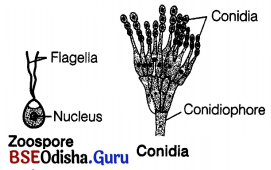
The two dissimilarities between them (zoospore and conidium) are as follows
| Zoospore | Conidium |
| It is found usually in algae. | It is found usually in fungi. |
| Flagellated | Non-flagellated |
| Formed inside a sporangium (endogenously). | Formed at the tip of conidiophores (exogenously). |
The feature that is common in zoospores and conidia is that both of these spores facilitate the process of reproduction in asexually reproducing organisms.
Question 7.
Write a short note on budding in Hydra
Answer:
Budding is an asexual method of reproduction that takes place in Hydra. In this, the ectodermal interstitial cells multiply to form an outgrowth called bud, The bud grows consisting of ectoderm, endoderm and gastrovascular cavity. The bud develops mouth and tentacles at its free end. The fully grown bud separates from the parent body of the Hydra and grows into an adult.
Question 8.
Write a short note on gemmules.
Answer:
Gemmules They are internal buds formed during unfavourable condition. They give rise to new individuals in favourable conditions.
They are formed inside the body of sponges. Their formation is called as internal budding or endogenous budding.
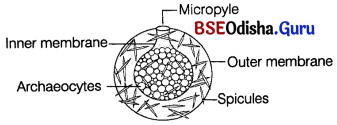
Gemmule in sponge
Question 9.
How does asexual reproduction take place in sponges?
Answer:
Freshwater sponges (e.g. Spongilla) reproduce asexually by forming gemmules.
Gemmules They are internal buds formed during unfavourable condition. They give rise to new individuals in favourable conditions.
They are formed inside the body of sponges. Their formation is called as internal budding or endogenous budding.

Gemmule in sponge
![]()
Question 10.
How will an organism be benefitted if it reproduces through spores?
Answer:
There are some benefits for the organism which reproduces through spore formation such as
- Reproduction through spores is a simple as well as faster mode of reproduction.
- The spores are light in weight, thus keep floating in the water/air. This helps in their dispersal.
- The spores are covered with a thick layer which enables them to survive in unfavourable conditions.
Question 11.
Briefly discuss different types of fission in organisms.
Answer:
Fission It is the phenomenon of division of the parent body into two or more daughter individuals.
Fission can be of following types
- Binary fission It is the type of fission in which parent body divides into two small, nearly equal ‘ sized daughter individuals. Each grows into an adult, e.g. Amoeba, Paramecium, etc.
- Multiple fission It is the type of fission in which parent body divides into many small daughter individuals simultaneously, e.g. Plasmodium (the malarial parasite), Amoeba (during unfavourable conditions).
Question 12.
Why vegetative propagation is considered as a type of asexual reproduction?
Answer:
Vegetative propagation is considered as a type of asexual reproduction because .
- it is uniparental reproduction.
- cells divide by mitosis and no reductional division occurs.
- it does not involve genetic variations.
Question 13.
Write short note on air layering.
Answwer:
Air layering (gootee) In this method, about 3.5 cm ring of bark is removed from the base of an aerial shoot. This area is then covered by a thick plaster of grafting clay. It consists of hay, cowdung, clay and water with small quantity of root promoting hormone (such as NAA or IBA).
A set up for micropropagation requires an explant. The most commonly used explants are the meristematic ends of the plants, i.e. stem tip, root tip, axillary bud, etc. This is because meristematic cells have high rate of cell division. These explants, along with culture vessel, cell division media and instruments, etc., are sterilised. The explant is then inoculated into a semi-solid nutrient medium contained in a culture vessel. This is followed by incubation of culture vessel at room temperature. After some time, multiple shoots start developing from the axillary buds. This is called axillary bud proliferation.
Question 14.
Why do internodal segments of sugarcane fail to propagate vegetatively even when they are in contact with damp soil?
Answer:
On the stems, new buds develop from the nodes. So, for vegetative reproduction of a plant through stem cutting it should have atleast one node. As internodal segments of the sugarcane do not have nodes, they fail to propagate vegetatively even when they are in contact with the damp soil.
Question 15.
Is it possible to consider vegetative propagation observed in certain plants like Bryophyllum, water hyacinth, ginger, etc., as a type of asexual reproduction? Give two/three reasons.
Answer:
The formation of new plants from vegetative units (vegetative propagules) such as buds, tubers, rhizomes, etc., is called vegetative propagation (vegetative reproduction).
Vegetative propagation is considered as a type of asexual reproduction because
- it is uniparental reproduction.
- cells divide by mitosis and no reductional division occurs.
- it does not involve genetic variations.
Question 16.
Observe the diagram given below and answer the questions that follows
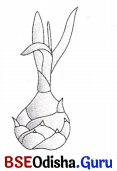
(i) What does the given diagram show?
(ii) Name any two plants (other than the one shown in fig.) which reproduce by the same method.
(iii) What are these plant parts referred to?
Answer:
(i) The given diagram shows a bulbil of Agave.
(ii) Two other plants which reproduce by the same method are Oxalis and lily.
(iii) These plant parts which help in vegetative (asexual) reproduction are referred to as vegetative propagules.
Question 17.
Write a short note on bulbils.
Answer:
Bulbils
These are fleshy buds produced in the axil of foliage leaves in place of axillary buds. They grow to form new plants, when shed/fall on the ground, e.g. Agave, Oxalis, Allium sativum, lily, etc.
Adventitious buds
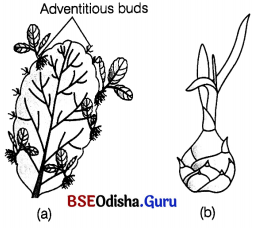
Vegetative propagules (a) Leaf buds of Bryophyllum , (b) Bulbil of Agave
The new plantlets in the plants like potato, sugarcane, banana, Dahlia, ginger, etc., arise invariably from the nodes present in the modified stems of these plants. When these nodes come in the contact of damp soil or water, they produce roots and new plants because of the presence of meristematic cells.
Question 18.
Write a short note on micropropagation.
Answer:
Micropropagation (Propagation by plant tissue culture) This method includes propagation of plants by culturing the cells, tissues and organs. It is called as tissue culture. Initially, the culturing of cells or tissues results in the formation of an undifferentiated mass of cells called callus, which later differentiates to form a large number of plantlets.
These plantlets are transferred to separate pots or nursery to grow them into plants. Tissue culture technique is useful in obtaining virus-free plants, disease-free plants, homozygous diploids and in quick commercial propagation of orchids, Gladiolus, Chrysanthemum, other ornamental plants.
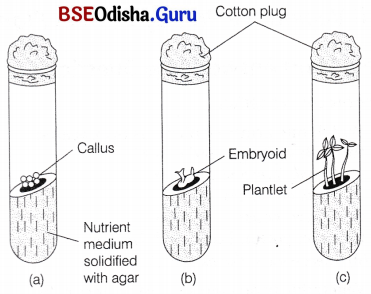
Question 19.
Mention the advantages and disadvantages of vegetative propagation.
Answer:
Advantages of Vegetative Propagation
- It is the only method of multiplication (rapid) in seedless plants, e.g. sugarcane, banana, seedless grape, seedless orange, etc.
- The important advantage of vegetative propagation is that a plant can be retained and multiplied indefinitely without any change or variation.
- Vegetative propagation by plant tissue culture (micropropagation) has been applied for the production of disease-free plants.
Disadvantages of Vegetative Propagation
- Vegetative propagules get easily decayed and are prone to viral, bacterial and fungal diseases.
- There are no variations. Therefore, the plants may show degeneration and in such plants there is a less adaptability to changed environment.
- There is no dispersal of vegetative propagules. Therefore, it causes overcrowding.
Differentiate between the following (for complete chapter)
Question 1.
Binary fission and Multiple fission.
Answer:
Differences between binary fission and multiple fission are as follows
| Binary fission | Multiple fission |
| It is the process of division of the parent body into two small, nearly equal sized daughter individuals where each grows into an adult. | It is the process of division of the parent body into many small daughter individuals simultaneously. |
| The nucleus divides once and is immediately followed by cytoplasmic division. | The nucleus several times. Thus, it is not followed cytoplasmic division. |
| It occurs under favourable conditions. | It occurs under unfavourable conditions. |
| e.g. Amoeba, Paramecium. | e.g. Plasmodium, Amoeba |
![]()
Question 2.
Sporogony and Budding.
Answer:
Differences between sporogony and budding are as follows
| Sporogony | Budding |
| In this, reproduction takes place by spore formation. | In this reproduction, an outgrowth or bud developing on the parent body develops into a new individual. |
| Spores are single-celled, reproductive bodies released from the parent body and are capable of growing into a new organism themselves, e.g. Penicillium, etc. | The daughter individual or bud remains attached tathe parent body until it is fully grown, e.g. Hydra, etc. |
Question 3.
Simple binary Fission and Transverse binary fission.
Answer:
Differences between simple binary fission and transverse binary fission are as follows
| Simple binary fission | Transverse binary fission |
| In this, fission of a parent into two daughter cells takes place along any possible plane. | In this, fission of a parent cell into two daughter cells takes place along the transverse or horizontal. |
| Plane of fission is not predetermined. | Plane of fission is predetermind. |
| The nucleus divides by mitosis, e.g. Amoeba. | The meganucleus divides by amitosis while the micronucleus divides by mitosis, e.g. Paramecium. Differentiate between the following (for complete chapter) |
